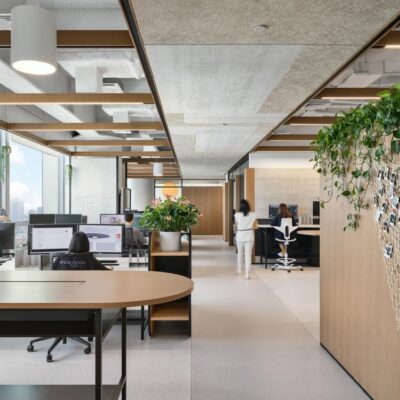The demand for coworking spaces has witnessed a significant surge in recent years. With the rise of remote work and the gig economy, professionals are increasingly looking for flexible, productive environments to work. However, with competition intensifying in the coworking industry, it’s important for businesses to employ effective marketing and advertising strategies to stand out.
Let’s explore how you can promote your coworking space and ensure maximum occupancy:
1. Understanding Coworking Space Advertising
The coworking sector has experienced exponential growth, propelled by remote work and the changes of the gig economy. Distinguishing your coworking space becomes crucial. Effective marketing and advertising are not just about visibility; they’re about forging connections and demonstrating value. For keywords that include your location (eg: “coworking space brooklyn”) you may choose to not set specific geo-targeting settings, while for generic keywords (eg: “coworking space near me”) you must always restrict targeting to the areas where you operate.
You can also leverage negative keyword lists to prevent your ads from appearing in irrelevant searches, ensuring a higher return on your ad budget.
Strategize Your Coworking Space’s Promotion for Peak Occupancy:
Your advertising campaign is the spearhead of your marketing efforts, essential for forging a powerful brand identity and attracting potential members. To make a strong first impression, consider a multi-faceted approach that combines digital and traditional advertising channels, ensuring broad coverage and targeted reach.
Digital Advertising Mastery
Google Ads: The power of search by creating ads that appear to potential members actively seeking coworking spaces. Use a keyword tool to target searches specific to coworking amenities, location, and community benefits. Incorporate ad extensions to provide additional information like contact details, links to membership pricing, or a tour booking option.
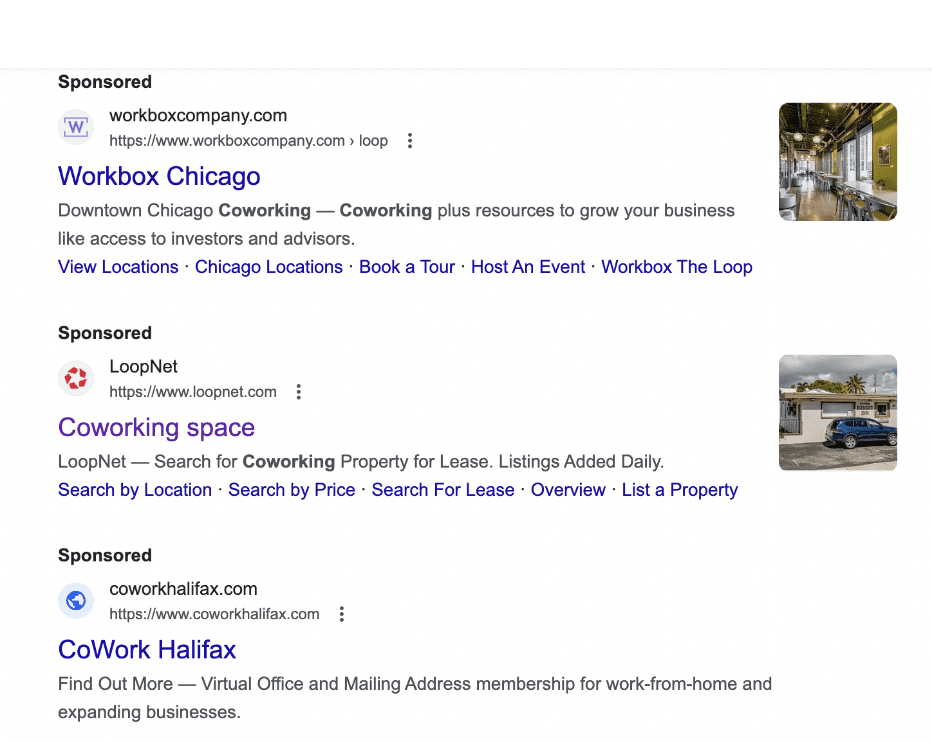
Social Media Advertising: Platforms such as Tiktok or Instagram offer sophisticated targeting options that allow you to reach potential members based on their interests, behaviors, and demographics. Create visually appealing ads that highlight the unique aspects of your coworking space, such as its design, events, and community. Use carousel ads to showcase different areas of your space or highlight testimonials from satisfied members. Keep in mind that in social ads, the creative and ad copy is very important, so you should consider allocating a portion of your ad budget to the content creation part.
Top Coworking Space Social Media Feeds
#1 Common Desk on Instagram
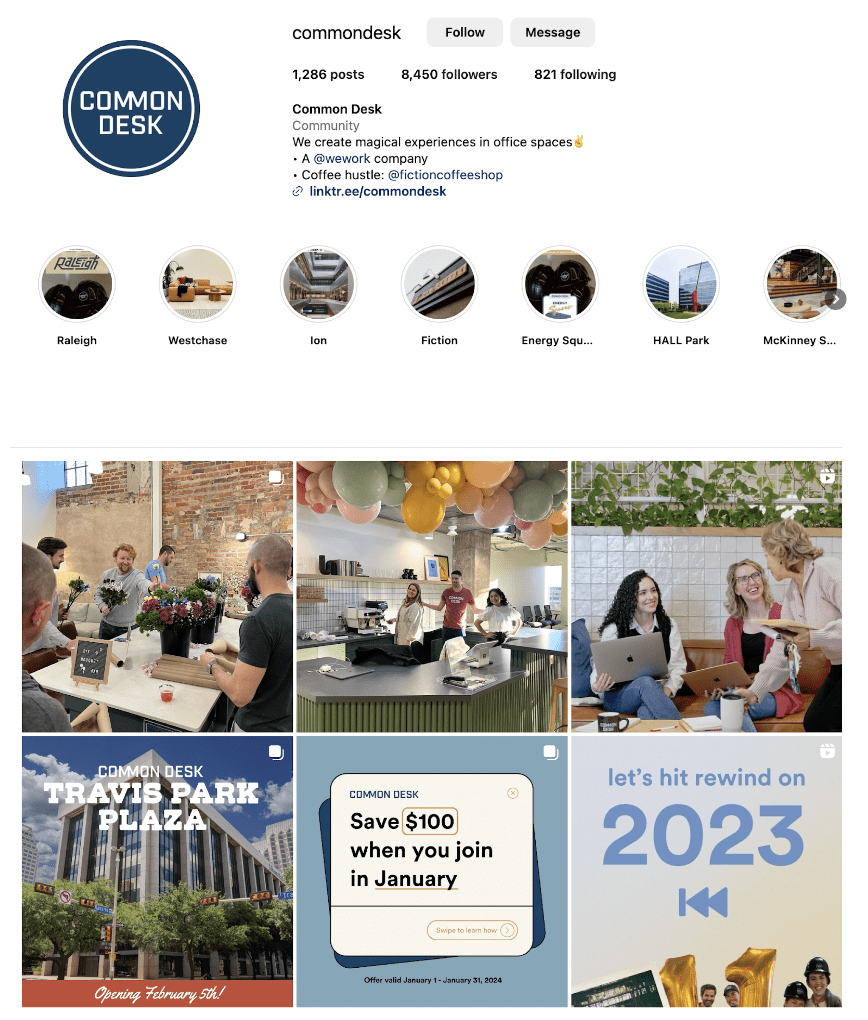
#2 Nottingham Office Twitter
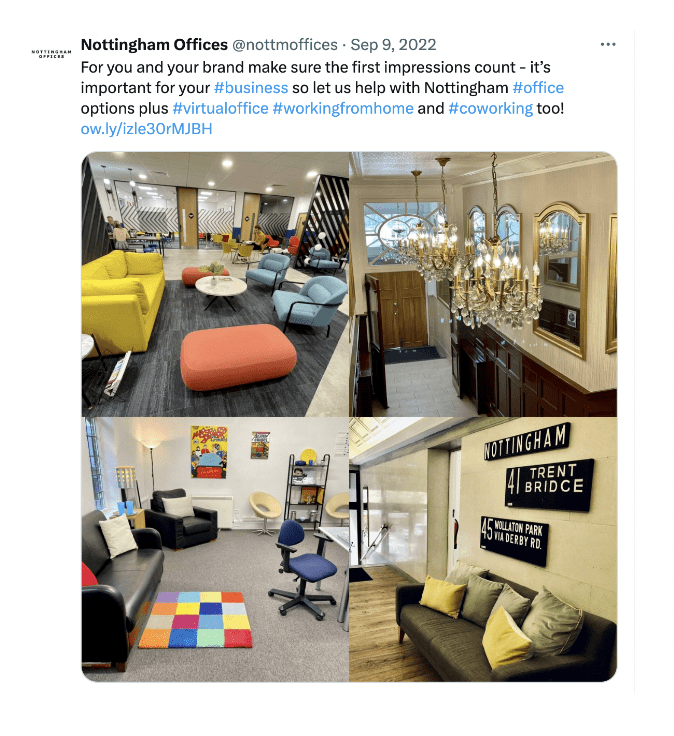
#3 Serendipity Labs Facebook
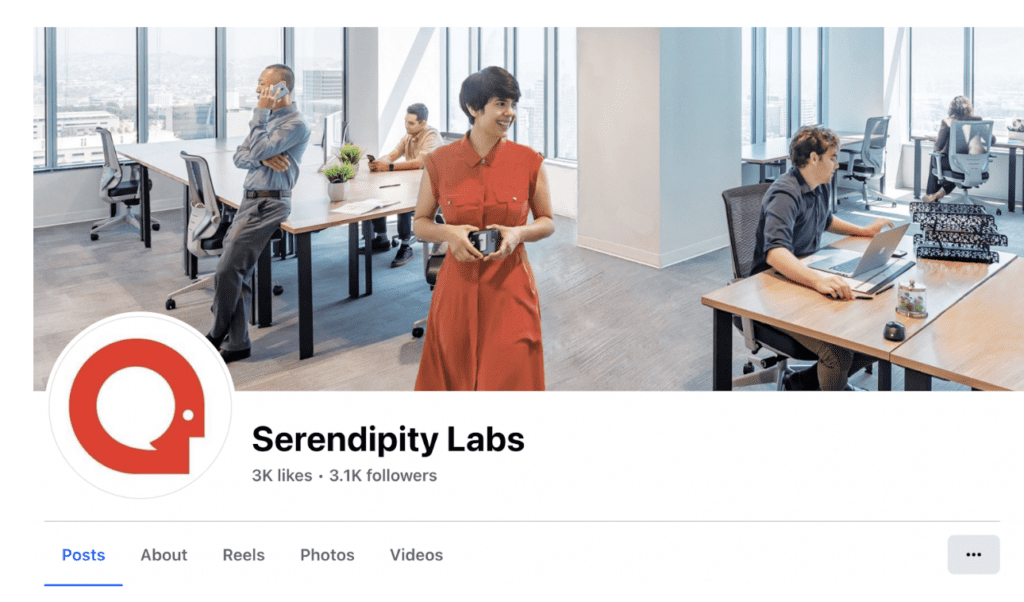
#4 Wibes Linkedin
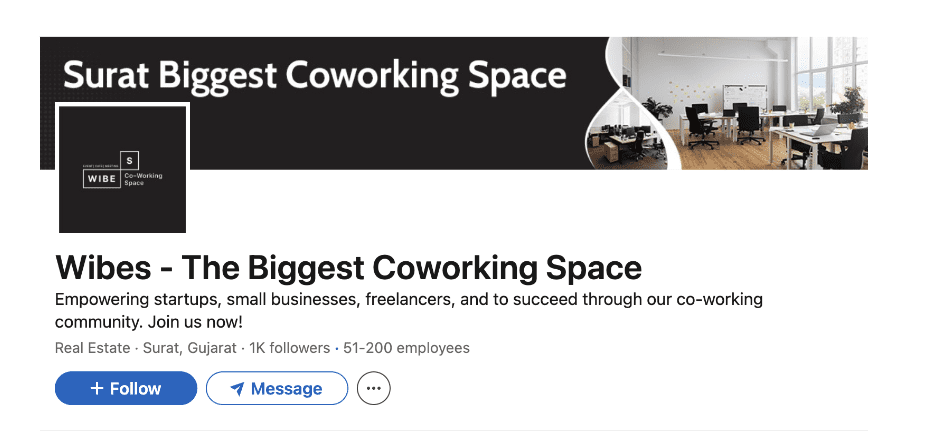
Your Coworking Space’s Local Visibility:
If you want to go more traditional, use strategic local advertising. Amplify your presence in the community by investing in local advertising channels. These platforms offer a direct route to potential members within your immediate area, fostering a sense of familiarity and trust.
Newspaper Features: Collaborate with local newspapers to feature your coworking space in articles, interviews, or community spotlights.
Magazine Partnerships: Partner with lifestyle and business magazines to showcase your coworking space through ads or editorial content. Highlight unique aspects such as your design, amenities, and the vibrant community you host. Special editions focusing on business, innovation, or work-life balance are particularly effective avenues.
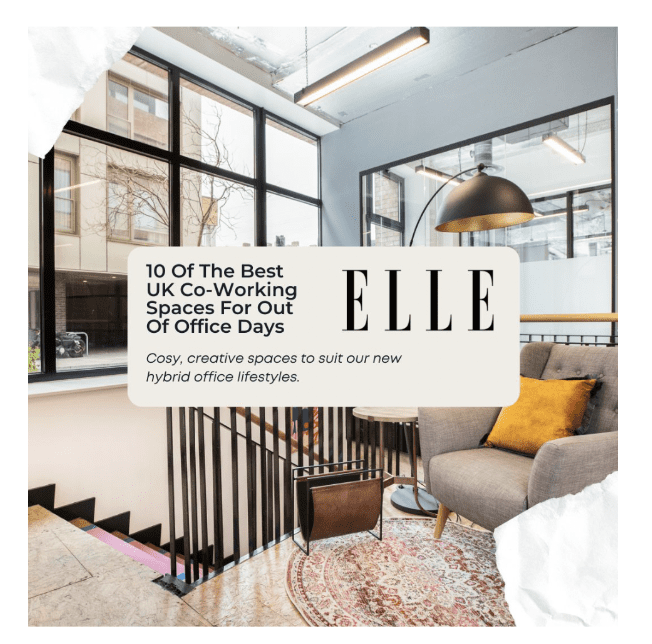
Radio Segments: Local radio stations to reach a broader audience. Participate in interviews, sponsor segments related to entrepreneurship or technology, or run ads during peak listening times. Radio channels often have a loyal listener base, offering an opportunity to engage with the community on a personal level.

Local Outreach: Engage with the local community. Whether it’s sponsoring events or hosting local gatherings, create a buzz around your brand in the community.

2. Innovative Promotion Tactics for Your Coworking Space
Engaging potential members and encouraging sign-ups require innovative and strategic promotional tactics. By implementing a mix of trial offers, discounted plans, and collaborative ventures, you can significantly enhance your coworking space’s appeal and drive occupancy rates.
Experience Before Commitment
Complimentary Access Passes: Beyond the traditional day/week trial, consider offering a variety of complimentary access passes. Options such as ‘Free Workday Fridays’ or complimentary workshops allow potential members to immerse themselves in your community, experience the amenities firsthand, and see the value in joining your coworking space.
Exclusive Member Events: Invite potential members to exclusive events or workshops held at your space.
Discount Schemes
Loyalty Discounts: Reward early adopters and long-term members with loyalty discount schemes. This could include decreasing membership fees over time or offering special rates for referrals.
Group and Corporate Packages: Develop attractive packages for teams, startups, and corporate clients. Offering flexible, discounted plans for groups can fill up your space quickly.
Strategic Collaborations and Partnerships
Local Business Tie-Ups: Forge partnerships with neighboring cafes, fitness centers, and other local businesses to offer exclusive deals to your members. For instance, ‘Wellness Wednesdays’ could feature special yoga classes or discounts at a nearby health food café, adding value to your memberships.
Themed Collaboration Days: Collaborate with local businesses for themed days like ‘Tech Tuesdays’, where tech companies and startups can showcase their products, offer free trials, or host interactive sessions.
Innovative Promotion Techniques
Member Spotlight Programs: Launch a member spotlight program to feature entrepreneurs and professionals from your community across your marketing channels.
Social Media Challenges and Contests: Use the power of social media by organizing challenges and contests that encourage engagement and visibility. For example, a photo contest with the theme ‘My Coworking Day’ can generate buzz and showcase the day-to-day life in your space, with prizes including membership discounts or free access to premium amenities.
By diversifying your promotional tactics and creating a compelling mix of experiences, discounts, and community engagements, your coworking space can stand out in a competitive market.
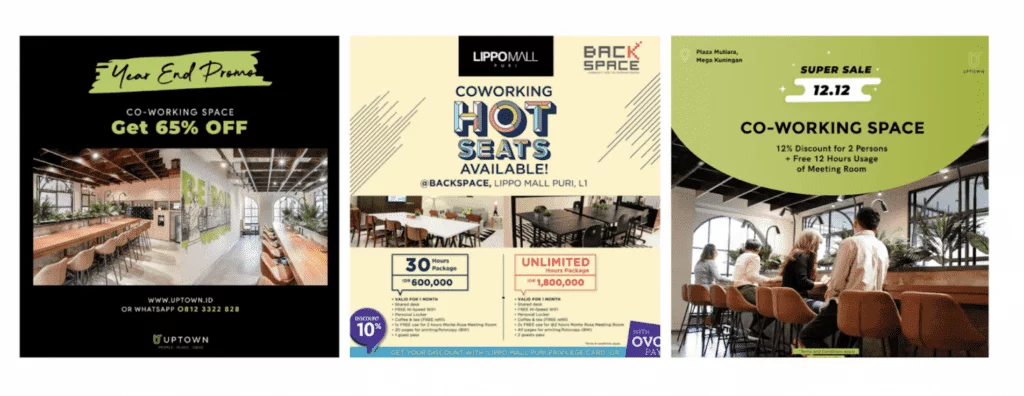
3. Marketing Your Coworking Space: Beyond the Basics
Here’s how to craft a marketing strategy that resonates deeply with your target audience and sets your coworking space apart.
Content Strategy:
Expert Panels and Webinars: Organize and share webinars featuring industry leaders and experts from your coworking community. Topics could range from entrepreneurship, digital marketing strategies, to wellness for professionals. This positions your space as a hub for learning and professional growth.
Interactive Blog Series: Develop an interactive blog series that invites readers to participate in discussions or complete certain actions. For example, a series on “The Future of Work” could include interviews with thought leaders, infographics on work trends, and interactive polls about remote work preferences. (or more related topics to coworking)
Engagement-Driven Social Media:
Utilize Instagram Stories or TikTok to share behind-the-scenes glimpses of daily operations, events, or even the process of setting up the coworking space.
Live AMA (Ask Me Anything) Sessions: Host live AMA sessions on platforms like Instagram or Facebook with founders, community managers, or members who have unique stories to share.
Community Highlights and Testimonials:
Member Success Stories: Share success stories of your members through video testimonials or detailed case studies on your website and social media. Highlighting how your coworking space contributed to their success can be a powerful tool in attracting new members.
Feature Collaborations and Projects: Showcase collaborative projects or ventures that were born within your coworking space. This could be a startup launch, a community outreach program, or a creative workshop.
Innovative Visual Content:
Virtual Tours: Offer virtual tours of your coworking space using 360-degree videos or augmented reality (AR) experiences. This allows potential members to explore the space remotely, providing a unique and immersive experience.
Infographics and Data Visualizations: Create and share infographics or data visualizations that highlight interesting statistics about coworking, productivity, or the freelance economy.
4. Expanding to multiple locations brings its own set of challenges.
Expanding your coworking space to multiple locations introduces a unique set of challenges that require strategic planning and execution. Here’s how to effectively manage and promote your growing network of spaces:
Localized Marketing Strategies: Develop marketing campaigns that are not only consistent with your overall brand identity but are also customized to fit the cultural and demographic characteristics of each location.
Consistent Brand Experience with Local Flair: While maintaining the core essence of your brand, infuse local elements into each space to create a unique yet familiar experience for members.
Cross-Location Membership Benefits: Implement a unified membership system that offers flexible access to multiple locations, providing value to members who travel or work in different areas.
Easy-to-go Integration Across Spaces: Ensure that your operational systems, including booking platforms and member management software, are integrated across all locations. For example: with Archie’s easy-to-go integration ensures that operational systems, including booking platforms, member management, and access control, work easily across all locations. It helps to enhance the member experience by providing a consistent and unified interface.
5. Measuring and Amplifying ROI of Your Marketing Initiatives
An effective marketing strategy is iterative.
Analyze Engagement: Use tools like Google Analytics to understand website engagement, and platforms like SurveyMonkey to gather member feedback.
Test and Optimize: Regularly test different promotions and marketing strategies. For instance, if a ‘Free Friday’ offer gets more traction than a ‘Member Mixer’, allocate resources accordingly.
Maximize Visibility with Coworking Directories: In addition to Google My Business, it’s prudent to leverage other directories that can broaden your coworking space’s exposure. These directories not only serve as valuable local citations but also expand your potential reach. Some noteworthy platforms include:
Yelp
Known for its trusted reviews and local business listings, can help your coworking space stand out to those searching for a reliable and well-regarded workspace in their area.
Yellow Pages
Though it might seem a bit traditional, Yellow Pages’ online platform is still a powerful tool for reaching local businesses and professionals. By listing your coworking space, you can tap into their vast user base looking for business services, including office and coworking spaces, enhancing your local visibility.
Liquid Space
Specifically designed for finding and booking flexible office spaces, is an ideal platform for coworking spaces looking to reach freelancers, remote workers, and businesses in need of temporary or flexible office solutions.
Loopnet
As a leading online marketplace for commercial real estate, can help position your coworking space in front of a professional audience looking for office spaces.
MLS
Listing your space on an MLS can increase your visibility among real estate professionals and potential clients looking for commercial leases, offering an additional channel to market your coworking space.
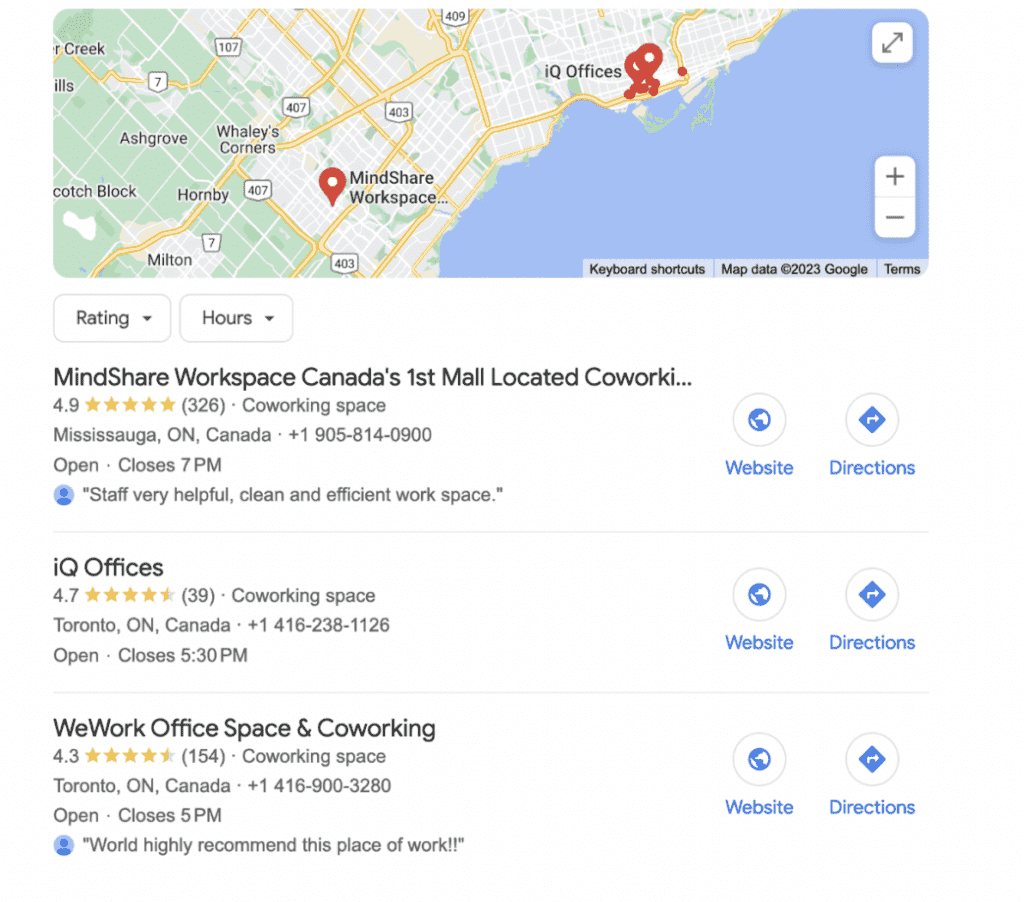
6.Cultivating Social Proof and Reputation Management
Trust and credibility can significantly influence a prospect’s decision to join your coworking space.
Gather Reviews: Encourage your satisfied members to leave positive reviews on platforms like Google, Yelp, and Facebook. This creates a positive online reputation and helps potential members trust your brand.
Leverage Testimonials: Feature testimonials on your website and marketing materials. Real-life experiences from current members can showcase the value your space provides.
Engage with Feedback: Respond to reviews, both positive and negative. Addressing concerns openly demonstrates your commitment to member satisfaction.
Conclusion
Marketing and advertising for coworking spaces go beyond just getting the word out. It’s about creating a brand, promoting a community, and ensuring that every member feels valued. By leveraging innovative strategies and continuously adapting to the evolving needs of professionals, coworking space owners can ensure sustained growth and success in a competitive market.























![Coworking Space Rules and Regulations [Guide + Template] The image shows a woman standing at a desk in a modern office space.](https://archieapp.co/blog/wp-content/uploads/2024/05/Best-coworking-management-software-compared-—-cover-image-400x400.jpg)
